University: PROJ6006 - EWS Project Leadership Analysis Case Study
VerifiedAdded on 2022/10/07
|12
|2448
|15
Case Study
AI Summary
This case study analyzes the leadership and project management strategies of Ecological Wastewater Solutions Pty Ltd (EWS), focusing on its global expansion. The paper explores strategic project leadership principles, emphasizing the importance of adapting to dynamic business environments. It examines the application of tools like PERT for supply chain sustainability and analyzes five types of power (legitimate, persuasive, relational, expert, and informational) within the project context. The study also discusses methods for developing self-managed teams in Agile projects, including minimum major speculation, self-regulating teams, and redundancy. Furthermore, it outlines steps efficient project managers take to mitigate challenges, such as implementing a proactive approach, identifying risk factors, and circumventing unrealistic expectations. The conclusion highlights the crucial role of evolving leadership abilities in enhancing team performance and project success, referencing the importance of these factors in project management and leadership evaluation.

Running head: ORGANIZATIONAL BEHAVIOUR
ORGANIZATIONAL BEHAVIOUR
Name of the Student:
Name of the University:
Author note:
ORGANIZATIONAL BEHAVIOUR
Name of the Student:
Name of the University:
Author note:
Paraphrase This Document
Need a fresh take? Get an instant paraphrase of this document with our AI Paraphraser
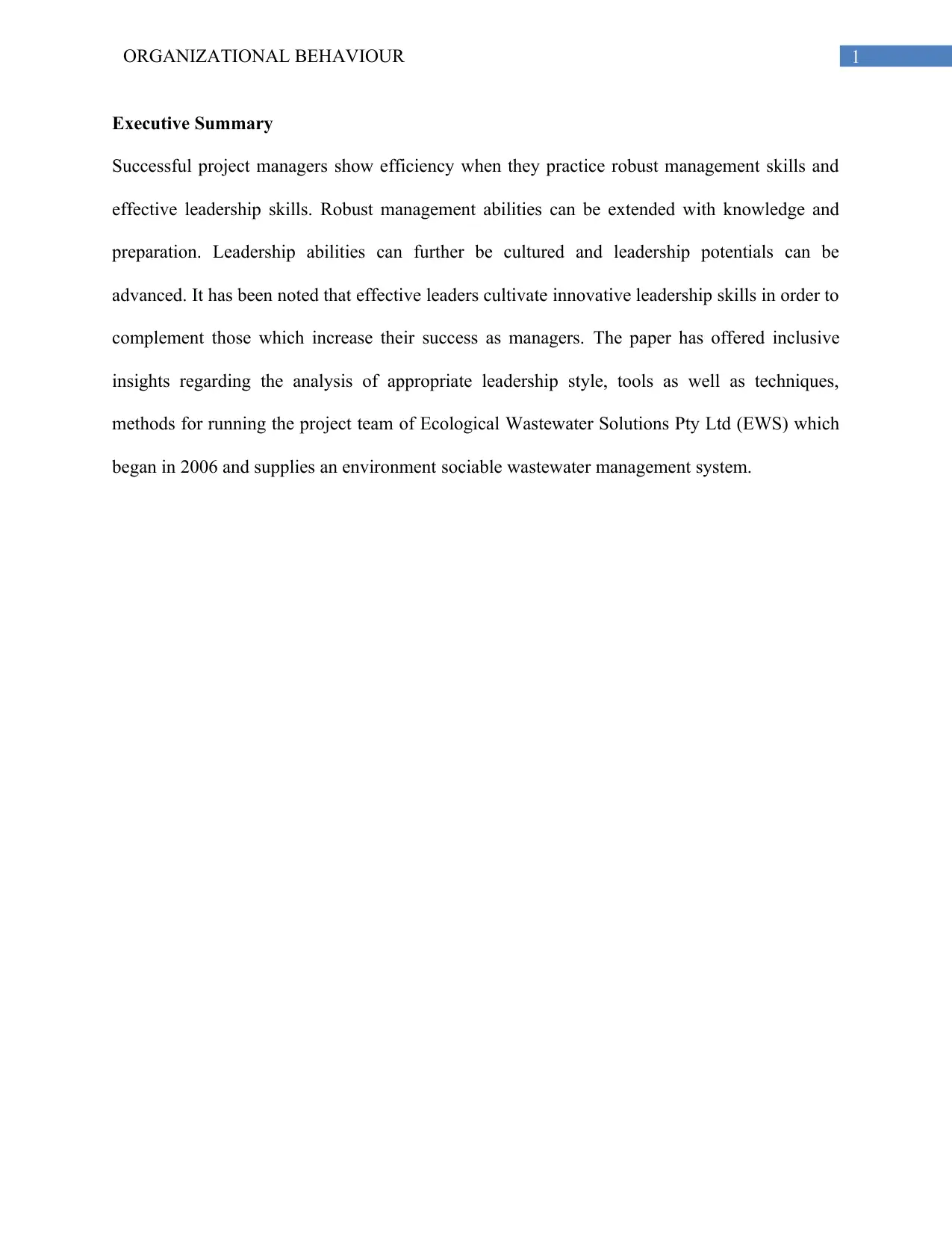
1ORGANIZATIONAL BEHAVIOUR
Executive Summary
Successful project managers show efficiency when they practice robust management skills and
effective leadership skills. Robust management abilities can be extended with knowledge and
preparation. Leadership abilities can further be cultured and leadership potentials can be
advanced. It has been noted that effective leaders cultivate innovative leadership skills in order to
complement those which increase their success as managers. The paper has offered inclusive
insights regarding the analysis of appropriate leadership style, tools as well as techniques,
methods for running the project team of Ecological Wastewater Solutions Pty Ltd (EWS) which
began in 2006 and supplies an environment sociable wastewater management system.
Executive Summary
Successful project managers show efficiency when they practice robust management skills and
effective leadership skills. Robust management abilities can be extended with knowledge and
preparation. Leadership abilities can further be cultured and leadership potentials can be
advanced. It has been noted that effective leaders cultivate innovative leadership skills in order to
complement those which increase their success as managers. The paper has offered inclusive
insights regarding the analysis of appropriate leadership style, tools as well as techniques,
methods for running the project team of Ecological Wastewater Solutions Pty Ltd (EWS) which
began in 2006 and supplies an environment sociable wastewater management system.
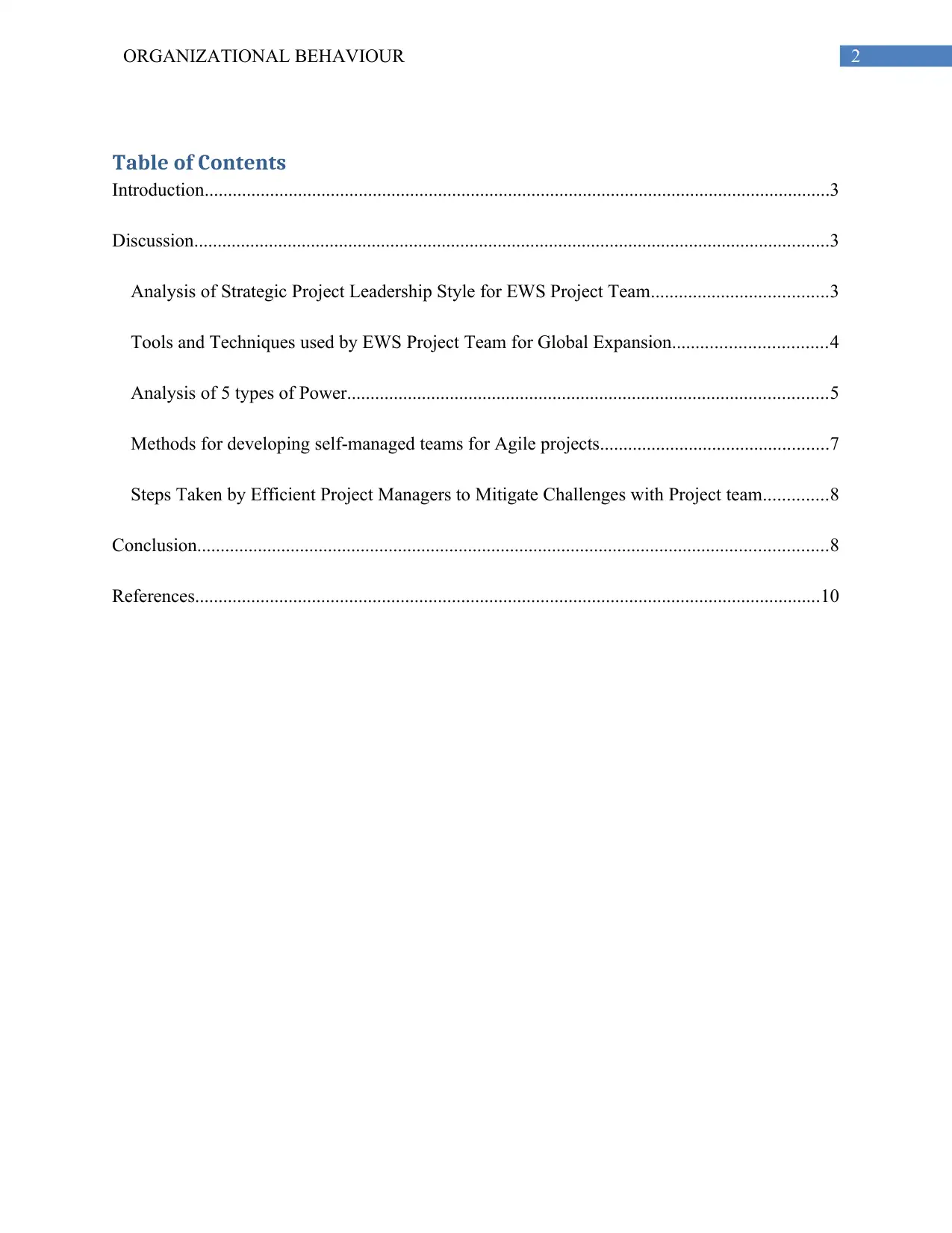
2ORGANIZATIONAL BEHAVIOUR
Table of Contents
Introduction......................................................................................................................................3
Discussion........................................................................................................................................3
Analysis of Strategic Project Leadership Style for EWS Project Team......................................3
Tools and Techniques used by EWS Project Team for Global Expansion.................................4
Analysis of 5 types of Power.......................................................................................................5
Methods for developing self-managed teams for Agile projects.................................................7
Steps Taken by Efficient Project Managers to Mitigate Challenges with Project team..............8
Conclusion.......................................................................................................................................8
References......................................................................................................................................10
Table of Contents
Introduction......................................................................................................................................3
Discussion........................................................................................................................................3
Analysis of Strategic Project Leadership Style for EWS Project Team......................................3
Tools and Techniques used by EWS Project Team for Global Expansion.................................4
Analysis of 5 types of Power.......................................................................................................5
Methods for developing self-managed teams for Agile projects.................................................7
Steps Taken by Efficient Project Managers to Mitigate Challenges with Project team..............8
Conclusion.......................................................................................................................................8
References......................................................................................................................................10
⊘ This is a preview!⊘
Do you want full access?
Subscribe today to unlock all pages.

Trusted by 1+ million students worldwide
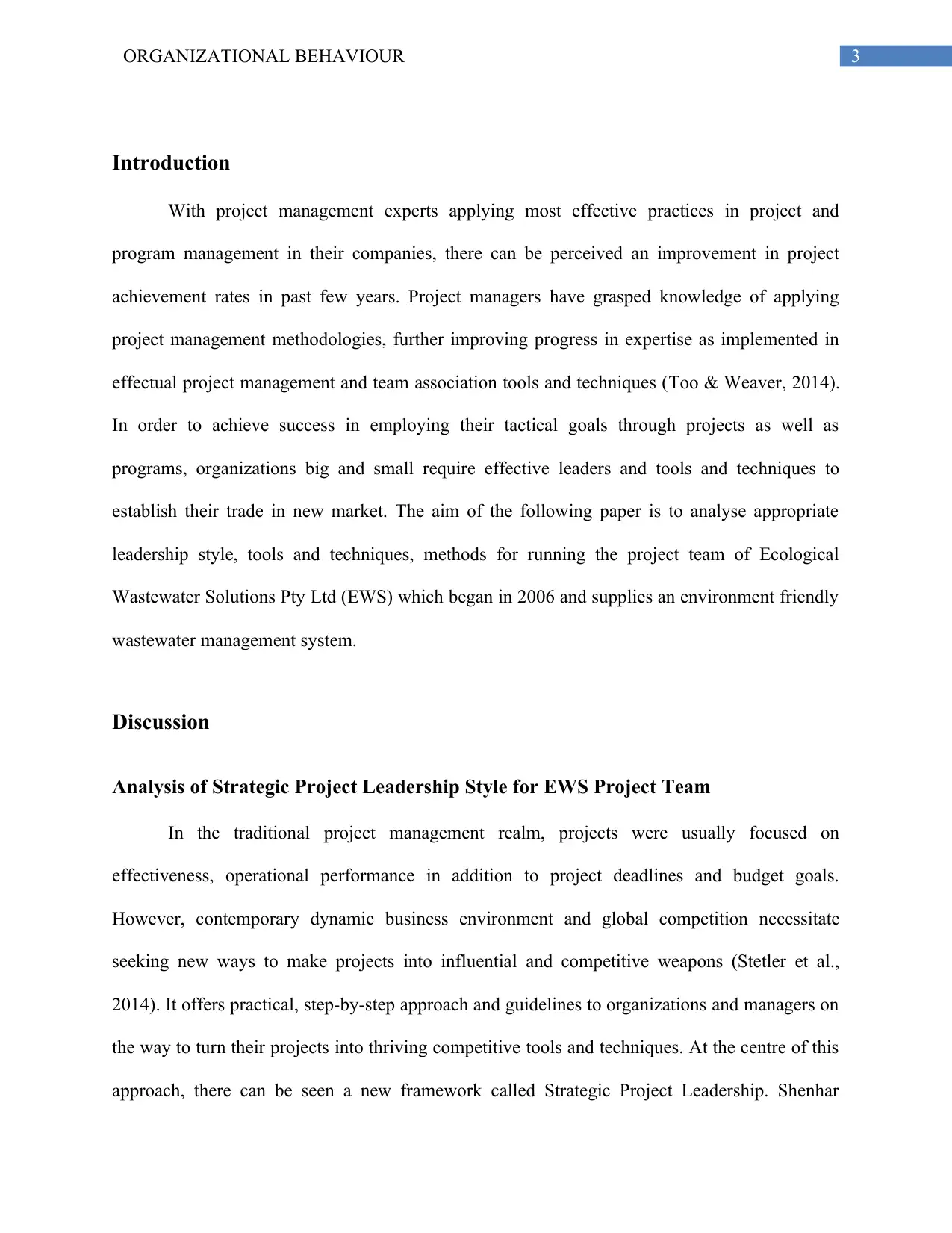
3ORGANIZATIONAL BEHAVIOUR
Introduction
With project management experts applying most effective practices in project and
program management in their companies, there can be perceived an improvement in project
achievement rates in past few years. Project managers have grasped knowledge of applying
project management methodologies, further improving progress in expertise as implemented in
effectual project management and team association tools and techniques (Too & Weaver, 2014).
In order to achieve success in employing their tactical goals through projects as well as
programs, organizations big and small require effective leaders and tools and techniques to
establish their trade in new market. The aim of the following paper is to analyse appropriate
leadership style, tools and techniques, methods for running the project team of Ecological
Wastewater Solutions Pty Ltd (EWS) which began in 2006 and supplies an environment friendly
wastewater management system.
Discussion
Analysis of Strategic Project Leadership Style for EWS Project Team
In the traditional project management realm, projects were usually focused on
effectiveness, operational performance in addition to project deadlines and budget goals.
However, contemporary dynamic business environment and global competition necessitate
seeking new ways to make projects into influential and competitive weapons (Stetler et al.,
2014). It offers practical, step-by-step approach and guidelines to organizations and managers on
the way to turn their projects into thriving competitive tools and techniques. At the centre of this
approach, there can be seen a new framework called Strategic Project Leadership. Shenhar
Introduction
With project management experts applying most effective practices in project and
program management in their companies, there can be perceived an improvement in project
achievement rates in past few years. Project managers have grasped knowledge of applying
project management methodologies, further improving progress in expertise as implemented in
effectual project management and team association tools and techniques (Too & Weaver, 2014).
In order to achieve success in employing their tactical goals through projects as well as
programs, organizations big and small require effective leaders and tools and techniques to
establish their trade in new market. The aim of the following paper is to analyse appropriate
leadership style, tools and techniques, methods for running the project team of Ecological
Wastewater Solutions Pty Ltd (EWS) which began in 2006 and supplies an environment friendly
wastewater management system.
Discussion
Analysis of Strategic Project Leadership Style for EWS Project Team
In the traditional project management realm, projects were usually focused on
effectiveness, operational performance in addition to project deadlines and budget goals.
However, contemporary dynamic business environment and global competition necessitate
seeking new ways to make projects into influential and competitive weapons (Stetler et al.,
2014). It offers practical, step-by-step approach and guidelines to organizations and managers on
the way to turn their projects into thriving competitive tools and techniques. At the centre of this
approach, there can be seen a new framework called Strategic Project Leadership. Shenhar
Paraphrase This Document
Need a fresh take? Get an instant paraphrase of this document with our AI Paraphraser

4ORGANIZATIONAL BEHAVIOUR
(2015) has noted that Strategic Project leadership fundamentally focus on forming competitive
advantage and penetrating into market place. Strategic Project Leadership is categorized in six
principles, when followed will help organizations implement the strategic approach and further
advance the project in a strategic way (Muller & Turner, 2017). Drawing insights from the case
study of EWS, the organization is willing to expand worldwide thus requiring merging and
reconstitution of the existing actions through a process that will conciliate contradictory
international uniformity organisations and markets. At this juncture, EWS project team must
adhere to principles of Strategic Project Leadership and develop project managers into strategic
leaders. Strategic Leadership notes that managers must act as problem solvers to attain
determined goals and guarantee proper functioning at their levels of accountability. The first
principle of SLP proposes that project managers of former times must learn strategies to develop
the power of leadership that is to stimulate, persuade and create implication. Furthermore, as per
the view of Too and Weaver (2014), SLP skills tend to create the perspective and guidelines for
behaviour in order to achieve products’ competitive advantage and value. These principles will
aid EWS focus activities and foster behavioural which will make competitive advantage a
reality. EWS by applying new SLP skills will be able to persuade stakeholders, associates and
critics which encompass plans for long-term sustainability.
Tools and Techniques used by EWS Project Team for Global Expansion
Typical procedure of the PERT (Project Evaluation and Review Technique) of supply
chain is to primarily practise the known evaluation performance displays, utilize analytical
method, adapt given procedure and to execute quantitatively or qualitatively comparative
analysis to deliver the goal and correct evaluation of sustainable supply performance in a
particular operation period. However, by implementing PERT, EWS can ascertain that the aim of
(2015) has noted that Strategic Project leadership fundamentally focus on forming competitive
advantage and penetrating into market place. Strategic Project Leadership is categorized in six
principles, when followed will help organizations implement the strategic approach and further
advance the project in a strategic way (Muller & Turner, 2017). Drawing insights from the case
study of EWS, the organization is willing to expand worldwide thus requiring merging and
reconstitution of the existing actions through a process that will conciliate contradictory
international uniformity organisations and markets. At this juncture, EWS project team must
adhere to principles of Strategic Project Leadership and develop project managers into strategic
leaders. Strategic Leadership notes that managers must act as problem solvers to attain
determined goals and guarantee proper functioning at their levels of accountability. The first
principle of SLP proposes that project managers of former times must learn strategies to develop
the power of leadership that is to stimulate, persuade and create implication. Furthermore, as per
the view of Too and Weaver (2014), SLP skills tend to create the perspective and guidelines for
behaviour in order to achieve products’ competitive advantage and value. These principles will
aid EWS focus activities and foster behavioural which will make competitive advantage a
reality. EWS by applying new SLP skills will be able to persuade stakeholders, associates and
critics which encompass plans for long-term sustainability.
Tools and Techniques used by EWS Project Team for Global Expansion
Typical procedure of the PERT (Project Evaluation and Review Technique) of supply
chain is to primarily practise the known evaluation performance displays, utilize analytical
method, adapt given procedure and to execute quantitatively or qualitatively comparative
analysis to deliver the goal and correct evaluation of sustainable supply performance in a
particular operation period. However, by implementing PERT, EWS can ascertain that the aim of
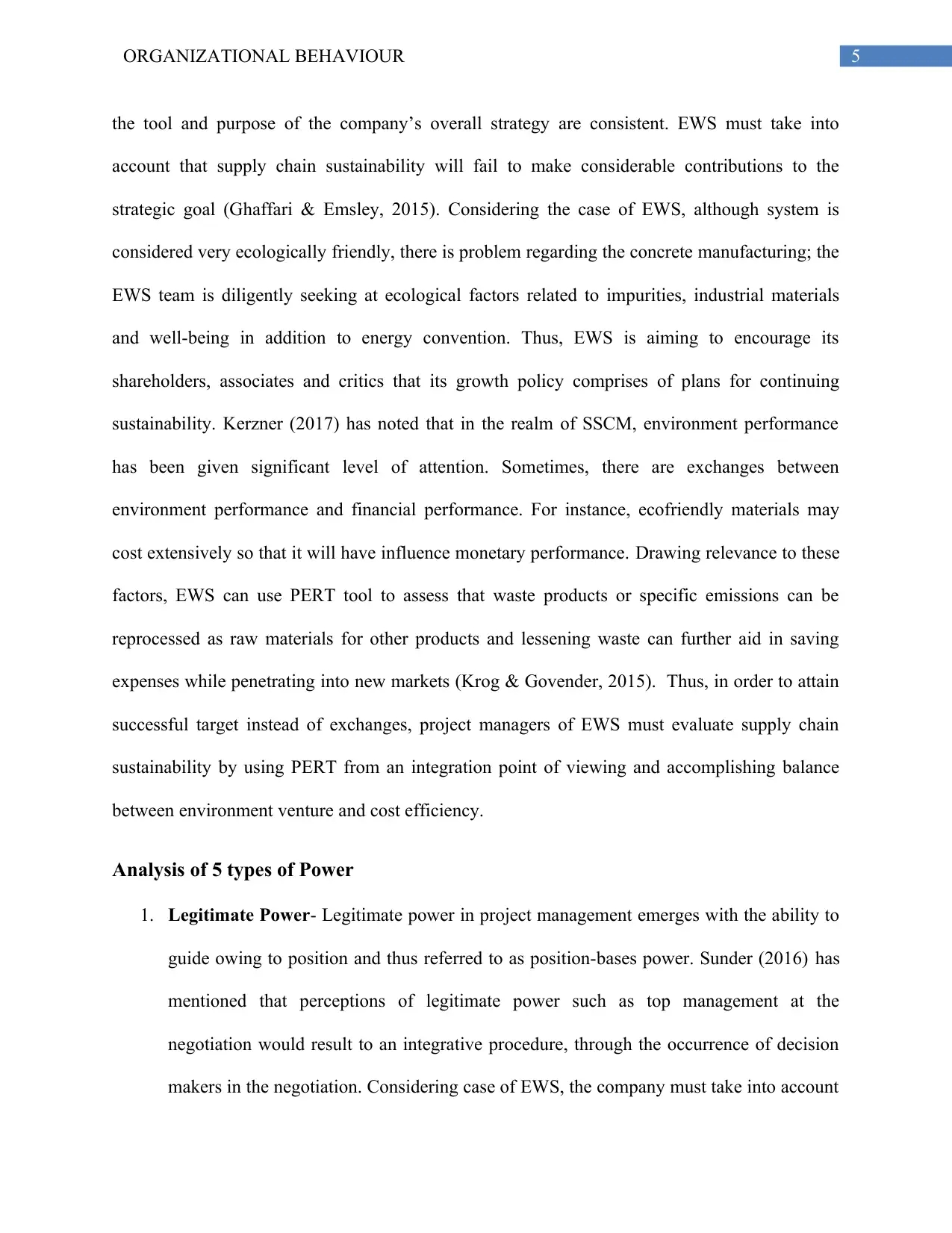
5ORGANIZATIONAL BEHAVIOUR
the tool and purpose of the company’s overall strategy are consistent. EWS must take into
account that supply chain sustainability will fail to make considerable contributions to the
strategic goal (Ghaffari & Emsley, 2015). Considering the case of EWS, although system is
considered very ecologically friendly, there is problem regarding the concrete manufacturing; the
EWS team is diligently seeking at ecological factors related to impurities, industrial materials
and well-being in addition to energy convention. Thus, EWS is aiming to encourage its
shareholders, associates and critics that its growth policy comprises of plans for continuing
sustainability. Kerzner (2017) has noted that in the realm of SSCM, environment performance
has been given significant level of attention. Sometimes, there are exchanges between
environment performance and financial performance. For instance, ecofriendly materials may
cost extensively so that it will have influence monetary performance. Drawing relevance to these
factors, EWS can use PERT tool to assess that waste products or specific emissions can be
reprocessed as raw materials for other products and lessening waste can further aid in saving
expenses while penetrating into new markets (Krog & Govender, 2015). Thus, in order to attain
successful target instead of exchanges, project managers of EWS must evaluate supply chain
sustainability by using PERT from an integration point of viewing and accomplishing balance
between environment venture and cost efficiency.
Analysis of 5 types of Power
1. Legitimate Power- Legitimate power in project management emerges with the ability to
guide owing to position and thus referred to as position-bases power. Sunder (2016) has
mentioned that perceptions of legitimate power such as top management at the
negotiation would result to an integrative procedure, through the occurrence of decision
makers in the negotiation. Considering case of EWS, the company must take into account
the tool and purpose of the company’s overall strategy are consistent. EWS must take into
account that supply chain sustainability will fail to make considerable contributions to the
strategic goal (Ghaffari & Emsley, 2015). Considering the case of EWS, although system is
considered very ecologically friendly, there is problem regarding the concrete manufacturing; the
EWS team is diligently seeking at ecological factors related to impurities, industrial materials
and well-being in addition to energy convention. Thus, EWS is aiming to encourage its
shareholders, associates and critics that its growth policy comprises of plans for continuing
sustainability. Kerzner (2017) has noted that in the realm of SSCM, environment performance
has been given significant level of attention. Sometimes, there are exchanges between
environment performance and financial performance. For instance, ecofriendly materials may
cost extensively so that it will have influence monetary performance. Drawing relevance to these
factors, EWS can use PERT tool to assess that waste products or specific emissions can be
reprocessed as raw materials for other products and lessening waste can further aid in saving
expenses while penetrating into new markets (Krog & Govender, 2015). Thus, in order to attain
successful target instead of exchanges, project managers of EWS must evaluate supply chain
sustainability by using PERT from an integration point of viewing and accomplishing balance
between environment venture and cost efficiency.
Analysis of 5 types of Power
1. Legitimate Power- Legitimate power in project management emerges with the ability to
guide owing to position and thus referred to as position-bases power. Sunder (2016) has
mentioned that perceptions of legitimate power such as top management at the
negotiation would result to an integrative procedure, through the occurrence of decision
makers in the negotiation. Considering case of EWS, the company must take into account
⊘ This is a preview!⊘
Do you want full access?
Subscribe today to unlock all pages.

Trusted by 1+ million students worldwide
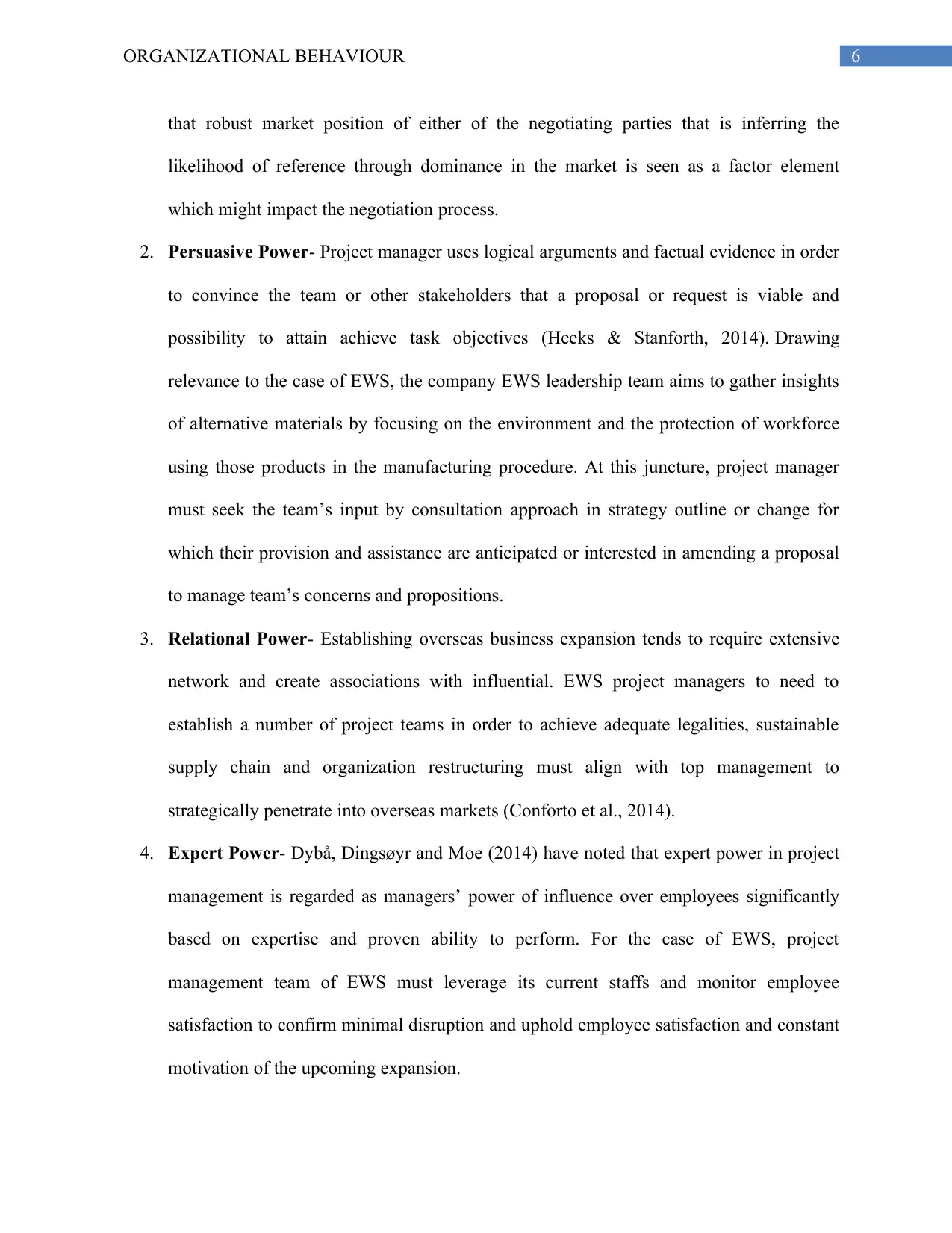
6ORGANIZATIONAL BEHAVIOUR
that robust market position of either of the negotiating parties that is inferring the
likelihood of reference through dominance in the market is seen as a factor element
which might impact the negotiation process.
2. Persuasive Power- Project manager uses logical arguments and factual evidence in order
to convince the team or other stakeholders that a proposal or request is viable and
possibility to attain achieve task objectives (Heeks & Stanforth, 2014). Drawing
relevance to the case of EWS, the company EWS leadership team aims to gather insights
of alternative materials by focusing on the environment and the protection of workforce
using those products in the manufacturing procedure. At this juncture, project manager
must seek the team’s input by consultation approach in strategy outline or change for
which their provision and assistance are anticipated or interested in amending a proposal
to manage team’s concerns and propositions.
3. Relational Power- Establishing overseas business expansion tends to require extensive
network and create associations with influential. EWS project managers to need to
establish a number of project teams in order to achieve adequate legalities, sustainable
supply chain and organization restructuring must align with top management to
strategically penetrate into overseas markets (Conforto et al., 2014).
4. Expert Power- Dybå, Dingsøyr and Moe (2014) have noted that expert power in project
management is regarded as managers’ power of influence over employees significantly
based on expertise and proven ability to perform. For the case of EWS, project
management team of EWS must leverage its current staffs and monitor employee
satisfaction to confirm minimal disruption and uphold employee satisfaction and constant
motivation of the upcoming expansion.
that robust market position of either of the negotiating parties that is inferring the
likelihood of reference through dominance in the market is seen as a factor element
which might impact the negotiation process.
2. Persuasive Power- Project manager uses logical arguments and factual evidence in order
to convince the team or other stakeholders that a proposal or request is viable and
possibility to attain achieve task objectives (Heeks & Stanforth, 2014). Drawing
relevance to the case of EWS, the company EWS leadership team aims to gather insights
of alternative materials by focusing on the environment and the protection of workforce
using those products in the manufacturing procedure. At this juncture, project manager
must seek the team’s input by consultation approach in strategy outline or change for
which their provision and assistance are anticipated or interested in amending a proposal
to manage team’s concerns and propositions.
3. Relational Power- Establishing overseas business expansion tends to require extensive
network and create associations with influential. EWS project managers to need to
establish a number of project teams in order to achieve adequate legalities, sustainable
supply chain and organization restructuring must align with top management to
strategically penetrate into overseas markets (Conforto et al., 2014).
4. Expert Power- Dybå, Dingsøyr and Moe (2014) have noted that expert power in project
management is regarded as managers’ power of influence over employees significantly
based on expertise and proven ability to perform. For the case of EWS, project
management team of EWS must leverage its current staffs and monitor employee
satisfaction to confirm minimal disruption and uphold employee satisfaction and constant
motivation of the upcoming expansion.
Paraphrase This Document
Need a fresh take? Get an instant paraphrase of this document with our AI Paraphraser
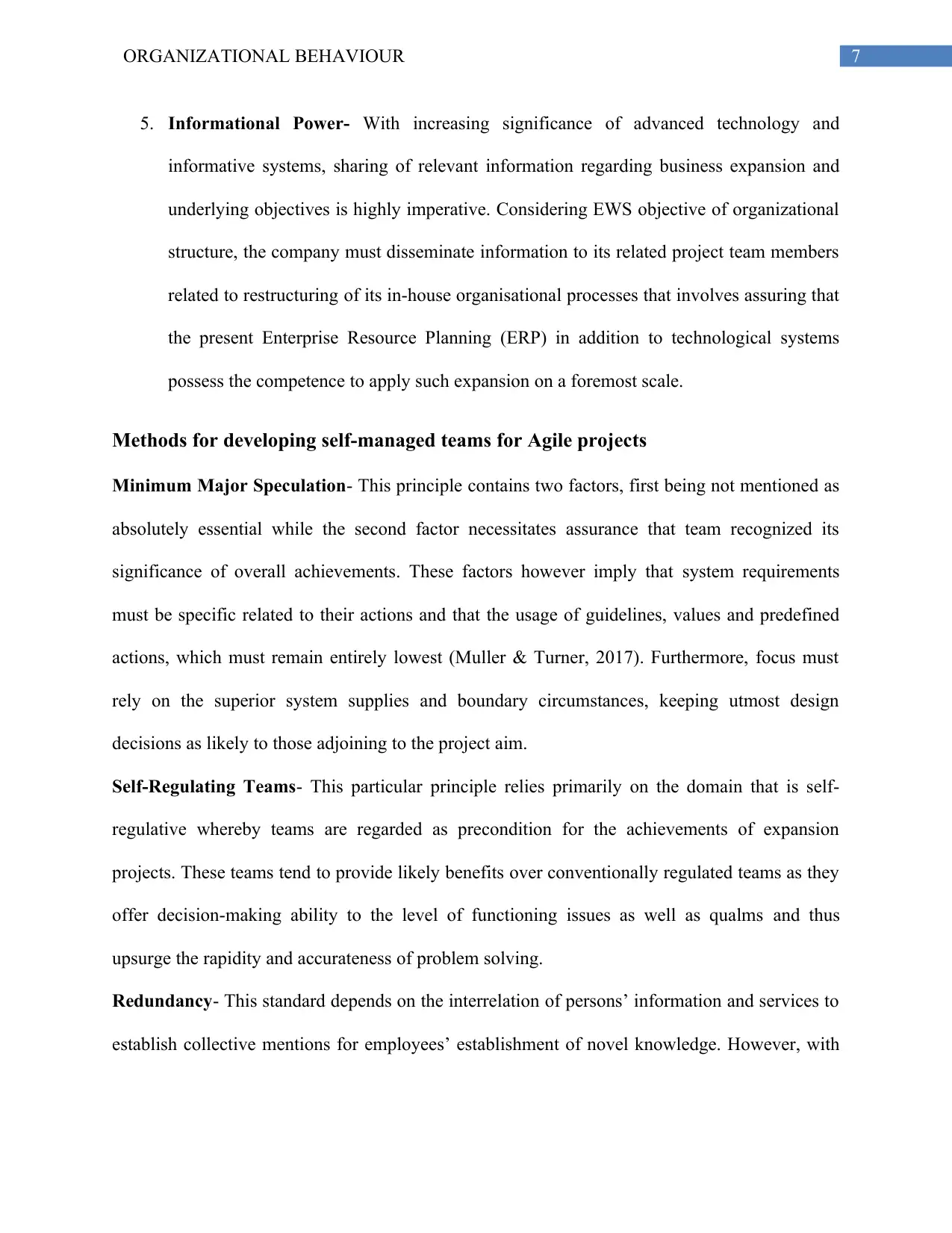
7ORGANIZATIONAL BEHAVIOUR
5. Informational Power- With increasing significance of advanced technology and
informative systems, sharing of relevant information regarding business expansion and
underlying objectives is highly imperative. Considering EWS objective of organizational
structure, the company must disseminate information to its related project team members
related to restructuring of its in-house organisational processes that involves assuring that
the present Enterprise Resource Planning (ERP) in addition to technological systems
possess the competence to apply such expansion on a foremost scale.
Methods for developing self-managed teams for Agile projects
Minimum Major Speculation- This principle contains two factors, first being not mentioned as
absolutely essential while the second factor necessitates assurance that team recognized its
significance of overall achievements. These factors however imply that system requirements
must be specific related to their actions and that the usage of guidelines, values and predefined
actions, which must remain entirely lowest (Muller & Turner, 2017). Furthermore, focus must
rely on the superior system supplies and boundary circumstances, keeping utmost design
decisions as likely to those adjoining to the project aim.
Self-Regulating Teams- This particular principle relies primarily on the domain that is self-
regulative whereby teams are regarded as precondition for the achievements of expansion
projects. These teams tend to provide likely benefits over conventionally regulated teams as they
offer decision-making ability to the level of functioning issues as well as qualms and thus
upsurge the rapidity and accurateness of problem solving.
Redundancy- This standard depends on the interrelation of persons’ information and services to
establish collective mentions for employees’ establishment of novel knowledge. However, with
5. Informational Power- With increasing significance of advanced technology and
informative systems, sharing of relevant information regarding business expansion and
underlying objectives is highly imperative. Considering EWS objective of organizational
structure, the company must disseminate information to its related project team members
related to restructuring of its in-house organisational processes that involves assuring that
the present Enterprise Resource Planning (ERP) in addition to technological systems
possess the competence to apply such expansion on a foremost scale.
Methods for developing self-managed teams for Agile projects
Minimum Major Speculation- This principle contains two factors, first being not mentioned as
absolutely essential while the second factor necessitates assurance that team recognized its
significance of overall achievements. These factors however imply that system requirements
must be specific related to their actions and that the usage of guidelines, values and predefined
actions, which must remain entirely lowest (Muller & Turner, 2017). Furthermore, focus must
rely on the superior system supplies and boundary circumstances, keeping utmost design
decisions as likely to those adjoining to the project aim.
Self-Regulating Teams- This particular principle relies primarily on the domain that is self-
regulative whereby teams are regarded as precondition for the achievements of expansion
projects. These teams tend to provide likely benefits over conventionally regulated teams as they
offer decision-making ability to the level of functioning issues as well as qualms and thus
upsurge the rapidity and accurateness of problem solving.
Redundancy- This standard depends on the interrelation of persons’ information and services to
establish collective mentions for employees’ establishment of novel knowledge. However, with
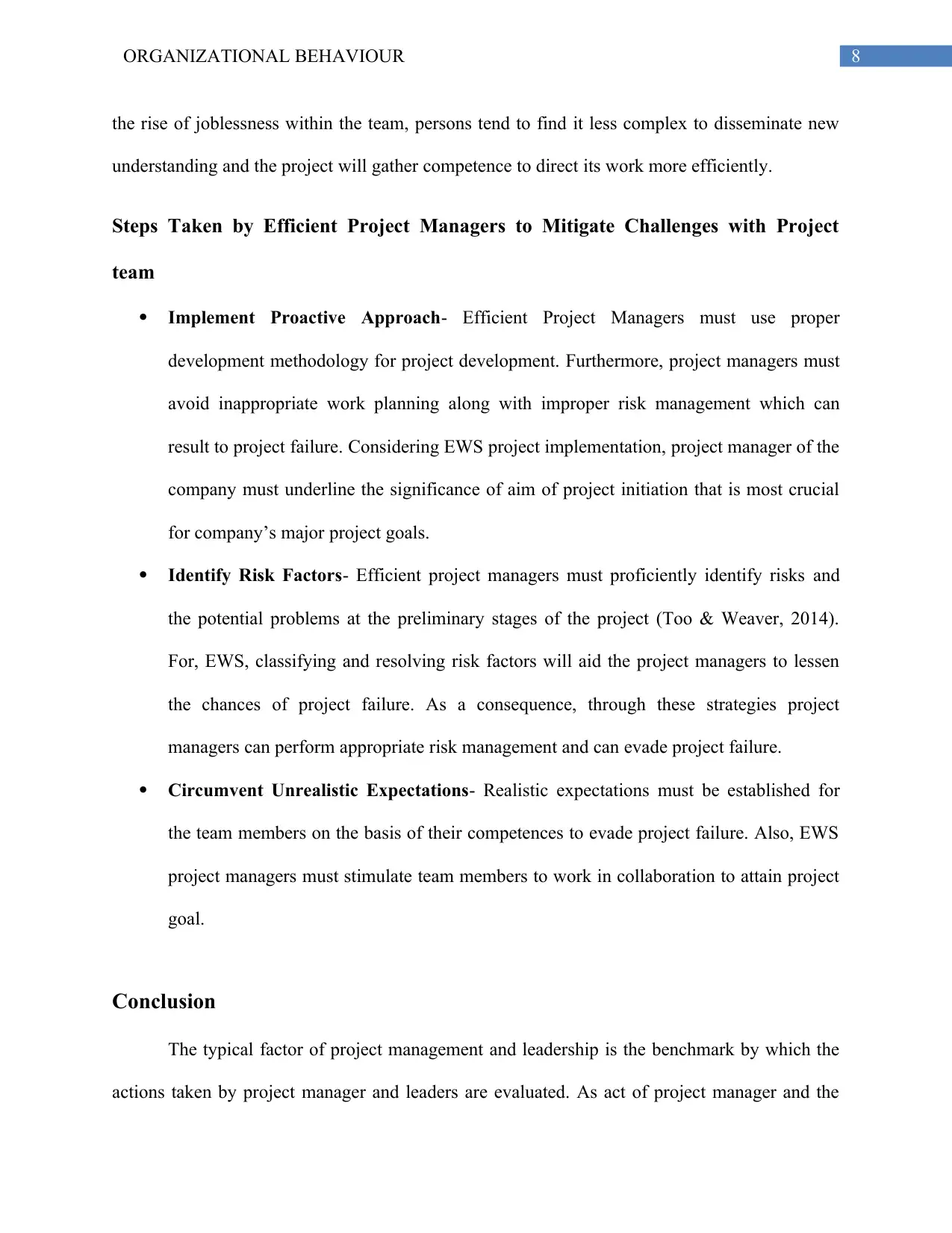
8ORGANIZATIONAL BEHAVIOUR
the rise of joblessness within the team, persons tend to find it less complex to disseminate new
understanding and the project will gather competence to direct its work more efficiently.
Steps Taken by Efficient Project Managers to Mitigate Challenges with Project
team
Implement Proactive Approach- Efficient Project Managers must use proper
development methodology for project development. Furthermore, project managers must
avoid inappropriate work planning along with improper risk management which can
result to project failure. Considering EWS project implementation, project manager of the
company must underline the significance of aim of project initiation that is most crucial
for company’s major project goals.
Identify Risk Factors- Efficient project managers must proficiently identify risks and
the potential problems at the preliminary stages of the project (Too & Weaver, 2014).
For, EWS, classifying and resolving risk factors will aid the project managers to lessen
the chances of project failure. As a consequence, through these strategies project
managers can perform appropriate risk management and can evade project failure.
Circumvent Unrealistic Expectations- Realistic expectations must be established for
the team members on the basis of their competences to evade project failure. Also, EWS
project managers must stimulate team members to work in collaboration to attain project
goal.
Conclusion
The typical factor of project management and leadership is the benchmark by which the
actions taken by project manager and leaders are evaluated. As act of project manager and the
the rise of joblessness within the team, persons tend to find it less complex to disseminate new
understanding and the project will gather competence to direct its work more efficiently.
Steps Taken by Efficient Project Managers to Mitigate Challenges with Project
team
Implement Proactive Approach- Efficient Project Managers must use proper
development methodology for project development. Furthermore, project managers must
avoid inappropriate work planning along with improper risk management which can
result to project failure. Considering EWS project implementation, project manager of the
company must underline the significance of aim of project initiation that is most crucial
for company’s major project goals.
Identify Risk Factors- Efficient project managers must proficiently identify risks and
the potential problems at the preliminary stages of the project (Too & Weaver, 2014).
For, EWS, classifying and resolving risk factors will aid the project managers to lessen
the chances of project failure. As a consequence, through these strategies project
managers can perform appropriate risk management and can evade project failure.
Circumvent Unrealistic Expectations- Realistic expectations must be established for
the team members on the basis of their competences to evade project failure. Also, EWS
project managers must stimulate team members to work in collaboration to attain project
goal.
Conclusion
The typical factor of project management and leadership is the benchmark by which the
actions taken by project manager and leaders are evaluated. As act of project manager and the
⊘ This is a preview!⊘
Do you want full access?
Subscribe today to unlock all pages.

Trusted by 1+ million students worldwide
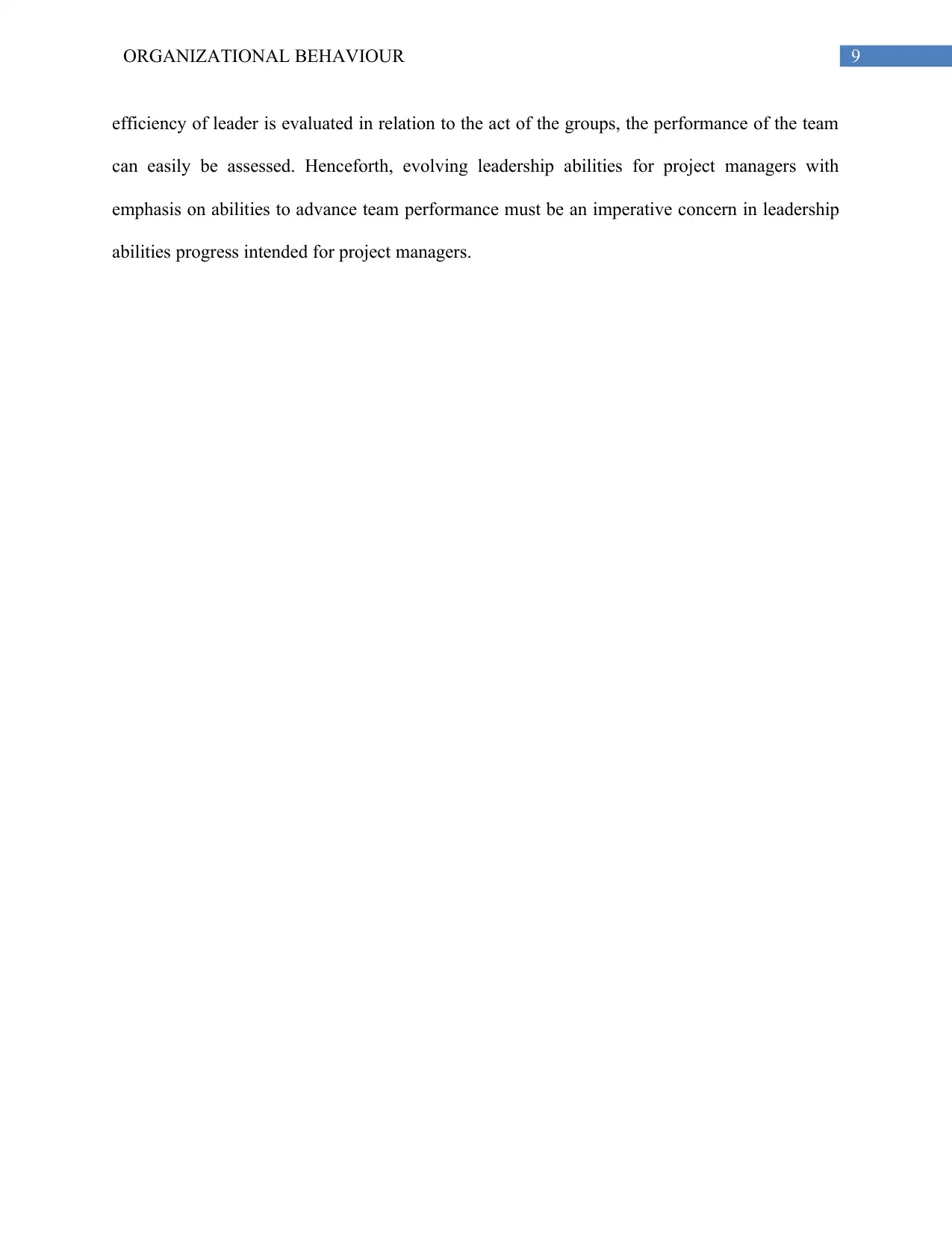
9ORGANIZATIONAL BEHAVIOUR
efficiency of leader is evaluated in relation to the act of the groups, the performance of the team
can easily be assessed. Henceforth, evolving leadership abilities for project managers with
emphasis on abilities to advance team performance must be an imperative concern in leadership
abilities progress intended for project managers.
efficiency of leader is evaluated in relation to the act of the groups, the performance of the team
can easily be assessed. Henceforth, evolving leadership abilities for project managers with
emphasis on abilities to advance team performance must be an imperative concern in leadership
abilities progress intended for project managers.
Paraphrase This Document
Need a fresh take? Get an instant paraphrase of this document with our AI Paraphraser

10ORGANIZATIONAL BEHAVIOUR
References
Conforto, E. C., Salum, F., Amaral, D. C., Da Silva, S. L., & De Almeida, L. F. M. (2014). Can
agile project management be adopted by industries other than software
development?. Project Management Journal, 45(3), 21-34.
Dybå, T., Dingsøyr, T., & Moe, N. B. (2014). Agile project management. In Software project
management in a changing world (pp. 277-300). Springer, Berlin, Heidelberg.
Ghaffari, M., & Emsley, M. W. (2015). Current status and future potential of the research on
Critical Chain Project Management. Surveys in Operations Research and Management
Science, 20(2), 43-54.
Heeks, R., & Stanforth, C. (2014). Understanding development project implementation: An
actor‐network perspective. Public Administration and Development, 34(1), 14-31.
Kerzner, H. (2017). Project management: a systems approach to planning, scheduling, and
controlling. John Wiley & Sons.
Krog, C. L., & Govender, K. (2015). The relationship between servant leadership and employee
empowerment, commitment, trust and innovative behaviour: A project management
perspective. SA Journal of Human Resource Management, 13(1), 12.
Muller, R., & Turner, J. R. (2017). Project-oriented leadership. Routledge.
Shenhar, A. (2015). What is strategic project leadership?. Open Economics and Management
Journal, 2(1).
Stetler, C. B., Ritchie, J. A., Rycroft‐Malone, J., & Charns, M. P. (2014). Leadership for
evidence‐based practice: strategic and functional behaviors for institutionalizing
EBP. Worldviews on Evidence
‐Based Nursing, 11(4), 219-226.
References
Conforto, E. C., Salum, F., Amaral, D. C., Da Silva, S. L., & De Almeida, L. F. M. (2014). Can
agile project management be adopted by industries other than software
development?. Project Management Journal, 45(3), 21-34.
Dybå, T., Dingsøyr, T., & Moe, N. B. (2014). Agile project management. In Software project
management in a changing world (pp. 277-300). Springer, Berlin, Heidelberg.
Ghaffari, M., & Emsley, M. W. (2015). Current status and future potential of the research on
Critical Chain Project Management. Surveys in Operations Research and Management
Science, 20(2), 43-54.
Heeks, R., & Stanforth, C. (2014). Understanding development project implementation: An
actor‐network perspective. Public Administration and Development, 34(1), 14-31.
Kerzner, H. (2017). Project management: a systems approach to planning, scheduling, and
controlling. John Wiley & Sons.
Krog, C. L., & Govender, K. (2015). The relationship between servant leadership and employee
empowerment, commitment, trust and innovative behaviour: A project management
perspective. SA Journal of Human Resource Management, 13(1), 12.
Muller, R., & Turner, J. R. (2017). Project-oriented leadership. Routledge.
Shenhar, A. (2015). What is strategic project leadership?. Open Economics and Management
Journal, 2(1).
Stetler, C. B., Ritchie, J. A., Rycroft‐Malone, J., & Charns, M. P. (2014). Leadership for
evidence‐based practice: strategic and functional behaviors for institutionalizing
EBP. Worldviews on Evidence
‐Based Nursing, 11(4), 219-226.

11ORGANIZATIONAL BEHAVIOUR
Sunder M, V. (2016). Lean Six Sigma project management–a stakeholder management
perspective. The TQM Journal, 28(1), 132-150.
Too, E. G., & Weaver, P. (2014). The management of project management: A conceptual
framework for project governance. International Journal of Project Management, 32(8),
1382-1394.
Too, E. G., & Weaver, P. (2014). The management of project management: A conceptual
framework for project governance. International Journal of Project Management, 32(8),
1382-1394.
Sunder M, V. (2016). Lean Six Sigma project management–a stakeholder management
perspective. The TQM Journal, 28(1), 132-150.
Too, E. G., & Weaver, P. (2014). The management of project management: A conceptual
framework for project governance. International Journal of Project Management, 32(8),
1382-1394.
Too, E. G., & Weaver, P. (2014). The management of project management: A conceptual
framework for project governance. International Journal of Project Management, 32(8),
1382-1394.
⊘ This is a preview!⊘
Do you want full access?
Subscribe today to unlock all pages.

Trusted by 1+ million students worldwide
1 out of 12
Related Documents
Your All-in-One AI-Powered Toolkit for Academic Success.
+13062052269
info@desklib.com
Available 24*7 on WhatsApp / Email
![[object Object]](/_next/static/media/star-bottom.7253800d.svg)
Unlock your academic potential
Copyright © 2020–2025 A2Z Services. All Rights Reserved. Developed and managed by ZUCOL.




